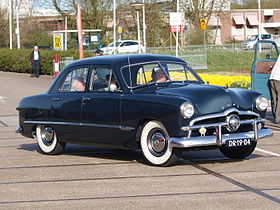The 1949 Ford is a line of cars produced by Ford from the 1949 to 1951 model years. The successor to the prewar 1941 Ford, the model line was the first full-size Ford designed after World War II, becoming the first Ford car line released after the deaths of Edsel Ford and Henry Ford. From 1946 to 1948, each of the American Big Three concentrated on the restoration of car production, offering updated versions of their 1941-1942 model lines. Released in June 1948, the 1949 Ford was the first major "postwar" American car line, beating Chevrolet to market by six months and Plymouth by nine.[4]
In response to its design, the model line would become called the "Shoebox Ford", denoting its slab-sided "ponton" design. While the design theme had been in use since the late 1920s to streamline automobiles, the 1949 Ford marked its widest-scale use, removing running boards entirely and integrating front and rear fenders into a single, smooth body form.
Following the 1948 introduction of the Ford F-Series line of trucks, the Ford line was now offered solely as a car. In another change, Ford introduced stand-alone model nameplates for 1950. Designed by artist Frank L. Engle,[5] the Ford crest emblem made its first appearance for 1950; in various forms, the emblem was used through the 1991 model year. In other firsts, this generation marked the first use of keyed ignition and the first automatic transmission option in Ford vehicles.
- ^ a b Norm Darwin, The History of Ford in Australia, 1986, pages 124-127
- ^ Flory, Jr., J. "Kelly" (2008). American Cars, 1946–1959 Every Model Every Year. McFarland & Company, Inc., Publishers. ISBN 978-0-7864-3229-5.
- ^ Ford (USA) Full-Size 2nd generation versions and types. automobile-catalog.com. 2010–2014. ISBN 978-83-931772-0-2. Retrieved 2014-04-13.
- ^ Flory Jr., J. "Kelly" (2008). American Cars, 1946-1959 Every Model Every Year. McFarland & Company, Inc., Publishers. pp. 210–211. ISBN 978-0-7864-3229-5.
- ^ "The Ford Crest". The Andalusia Star-News. Andalusia, Alabama. February 1, 1951. p. 7. Retrieved February 29, 2020 – via Newspapers.com.
